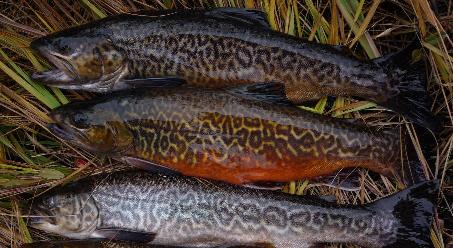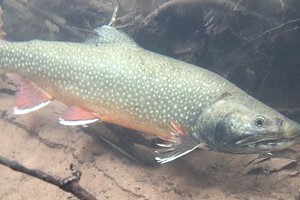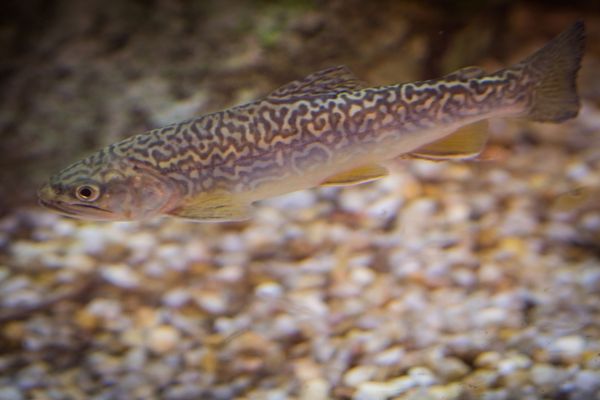While researching for an article on the differences between Trout and Salmon, I got side tracked by hybridization between the different groups of Salmonidae. It turns out, there are a lot of different trout hybrids out there.
For those who do not know, Salmonidae is the scientific family to which all ‘true’ salmon, trout, and char belong.
I said all true because the terms trout and salmon are thrown around quite frequently in common speech for example the Spotted Seatrout found in the Southern US, The Marble trout found in the seas around New Zealand (not to be confused with the marble trout in Europe, which is indeed a Salmonidae) and the Australian Salmon all belong to completely different classifications of fish. So despite the name trout or salmon, they are in no way Salmonidae.
So in this article, I want to share some of the more interesting hybrids which occur between Trout, Char, and Salmon.
Feel free to share any first-hand experiences with these or other hybrids in the comments below.
Trout are naturally very diverse; did you know there could be over 100 species of trout?
Tiger Trout (Brook x Brown)

Tiger trout, are a well-known hybrid within the Salmonidae family, they are commonly stocked due to their popularity and various advantages. These unique fish are created when a male brook trout fertilizes the eggs of a female brown trout.
Tiger trout are popular for stocking because they grow fast and are generally healthy. They are also quite aggressive making them easier to catch. Tiger trout for the most part are infertile (1 out of 75 four year old males in a study had viable sperm (1)).
Because for all practical purposes tiger trout are infertile it results in an improved growth rate and also prevents them from becoming an invasive species.
I do not think I am alone in thinking, that with their plentiful stripes tiger trout are among the most attractive Salmoidaes.
In streams where both brook trout and brown trout co-exist, wild tiger trout are known to occur. The cross is extremely rare in the wild because it requires water temperatures warm enough to cause a mutation within the brown trout eggs that creates an additional chromosome.
In the United States, most tiger trout are caught within the states of Nevada, Utah, and Massachusetts where hybrid stocking programs exist.
Cheetah Trout (Brook x Rainbow)
The cheetah trout is a little known hybrid between a female rainbow trout and a male brook trout. Cheetah trout are extremely difficult to breed in the lab so they are very rarely stocked and almost never encountered while fishing.
Like the tiger trout, cheetah trout are basically infertile. Cheetah trout have a low survival rate in the hatchery which means they are rarely bred and are even less likely to be stocked. Although some of them do appear to be fertile.
Just like their namesake the Cheetah, these hybrids are typically covered in dots.
Cheetah trout typically maintain the personality and behaviors of Rainbow trout which makes them aggressive and easy to catch.
I did some research, and the only place I could find them being stocked is in Victoria Australia where they were recently released into Lake Purrumbete.
On the topic of trout named after big cats, there is also ‘Leopard trout’ found in Alaska. But these are not a hybrid, but a color variation of rainbow trout. To add to the confusion, I also heard people refer to cheetah trout as leopard trout.
Splake (Brook x Lake)
Splakes are a hybrid between a male brook trout and a female lake trout.
Hybrids can occur between female brooks and male lakers but the survivial rate is extremely low.
Splakes do not typically occur in the wild due to differences in spawning behavior. Brook Char prefer to spawn in concentrated redds typically located in the shallow margins of rivers and streams while lake trout broadcast spawns over a large area on the lake floor.
With both parents, belonging to the same Genus Salvelinus (or Char) splake are indeed fertile and are capable of wild reproduction although it is extremely rare.
Splake are a popular stocking species because they grow fast and their low breeding success means population density can be fully managed with little threat of a wild population becoming invasive and threatening native species.

Brownbows (Brown x Rainbow)
Brownbows, a hybrid trout species, are often a subject of debate among fishermen, with some claiming they do not exist in the wild. While it is true that brownbows do not occur naturally, they can be bred through human intervention.
The origins of brownbows remain controversial, with claims of their initial breeding by geneticists at the University of Washington in the mid-1990s, as well as scientific studies dating back to the 1930s documenting their breeding.
Despite lacking the right to publish the photo, I have seen photographic evidence of mature brownbows breed sometime in the 1950’s. This indicates that scientists and hatcheries have been experimenting with them for a considerable period.
A brownbow is a hybrid resulting from the crossbreeding of a female rainbow trout and a male brown trout. These hybrids are exceptionally rare and require direct human intervention to be produced. Brown and rainbow trout spawn at different times of the year, which explains why brownbows cannot occur naturally in wild populations.
Brownbows typically exhibit the brownish coloration of brown trout, but with spots extending all the way into the tail. In lake environments, they are likely to become more silvery, resembling their maternal parent, the rainbow trout. While brownbows generally exhibit feeding behaviors more similar to rainbow trout, they can also retain the cautious nature commonly associated with brown trout.
The vast majority of brownbows are infertile, which initially held promise for their potential as an excellent stocking choice. Their inability to spawn offered the possibility of faster growth and increased resistance to whirling disease.
In the late 1990s, brownbow trout were stocked in selected lakes across California and Utah, and some fortunate anglers managed to catch them. However, the stocking program ultimately faced failure due to a high incidence of cataract development among the trout, leading to its discontinuation.
Brake (Lake x Brown)
Brakes might be the rarest trout hybrid on this list, there is very little information about them online. A brake is a cross between a female brown trout and a male lake trout.
The only hatchery that I am aware of producing brake trout was in Utah, as part of an experiment to produce a trout more resistant to whirling disease. Brake trout, like most of the stranger hybrids, were infertile.
Cuttbow (Rainbow x Cutthroat)
The hybrid between a rainbow and cutthroat trout is a cuttbow. These two species of trout are very closely related, and the hybrid has been known to occur frequently in wild populations.
In some regions, there is a concern that hybridization with invasive Rainbow trout could see the extinction of pure cutthroat in these fisheries.
Identification can be difficult but it is usually possible to tell if a fish has any rainbow genetics by looking for white tips on their fins. If a trout has both white tips, and an orange slash on its head it is almost certainly a cuttbow.
Co-nooks (Coho x Chinook)
Co-nooks are a naturally occurring hybrid between coho and chinook salmon. In some areas, it was estimated that just over half a percent of wildly occur chinook Salmon were actually hybrids.
Co-nooks are fertile and second generation hybrids have also been found in the wild.
Co-nook hybridization is more likely to occur in years of extreme drought where spawning fish are forced into the some spawning grounds. In normal years the two species spawn at different times which reduces the chances of cross breeding occurring.
Visual Identification can be difficult and usually requires a genetic test to know for sure.
Pinooks (Chinook x Pink)
This is the naturally occurring cross between Chinook and Pink salmon. I have read reports, that these hybrids are more common in the great lakes due to less predation but they can exist anywhere these two species coinhabit.
For reasons, I do not understand most Pinooks are also male.
Pinooks can be a bit difficult to identify based on sight alone. They typically have less pronounced back humps and grow larger than pure breed Pinks. Their coloration can also begin resembling that of a coho.
To give a definitive identification typically requires the expertise of a trained fish biologist (Ichthyologists) who will need to analyze their teeth, gill rakers, their fin rays/
Chumpies (Chum x Pink)
The chumpie is a cross between chum and pink salmon.
They are rarely caught by recreational fishermen but they are caught occasionally by commercial fishermen.
There has been some commercial interest to breed and raise them. The salmon farmers were hoping to produce a hybrid with the pink flesh of the pink salmon and the yearly spawning of the chum. Apparently, they have darker flesh than the parents and are more likely to take lures than the chum. The breeding operation saw some success, but it never developed into a fishery.
The hybrids are strong enough to reach maturity, but there is some evidence to suggest they do not spawn. Chumpies today are rarely seen in the wild.
Brown Trout x Atlantic Salmon
I will finish this quick write up about the cross between the Brown Trout and Atlantic Salmon.
I do not believe this hybrid has a name, but it is fairly common.
This hybrid does occur in the wild and there is conflicting information published on whether they can produce viable young or not.
This hybrid generated some controversy a few years back when it was discovered that genetically modified farmed Atlantic Salmon can hybridize with wild brown trout and the offspring were capable of outcompeting wild fish.
There is also some controversy surrounding the record brown trout caught in the United Kingdom, some experts now believe it is actually a naturally occurring hybrid.
Rainbow trout X Coho Salmon
These species have been known to hybridize. If they have a common name, I am not aware of it.
In the wild, they spawn at different times of the year, so they are unlikely to occur naturally and are usually the outcome of experimenting within hatcheries.
If I find out any more information, I will expand this section.


I have caught a brown trout rainbow cross at the headwaters of herring creek reservoir in California’s sierra Nevada mountains. Since there is no stocking of this extremely rare cross breed, the only conclusion is that it was derived naturally. I caught it on a caddis pupa I scraped off a rock with a very small hook and no weight. The water is crystal clear and the fish are very weary. The fish had all the markings of a brown trout. Yellow body, brown trout speckle pattern, with the brightest red stripe across it’s body and a bright red patch on its jaw. I released the 15″ fish because I could not kill something so rare and beautiful.
Thanks for the comment. Always interesting to hear about the possibility of wildly occurring hybrids. This will be an extraordinarily rare occurrence if it is a naturally occurring brownbow. Did you manage to get any photos?
Another possibility is that it is a rainbow with atypical color. Either way, still a very interesting report.
Interesting Article. Which of these hybrids are fertile? Sterile hybrids are safe the claim goes, but how long before science fixes this; anything is possible.
I remain a whole foods vegan.
The majority are sterile, but in hybrids between more closely related species and genus then occasionally one of the hybrids offspring are technically fertile. Typically something like 1-2% of them. do develop gonads and act like they ready to spawn, but have not heard of any viable offspring from such fish. The chance of these trout breeding with wild populations is pretty slim because spawning habit and time will likely differ from the parent stock.
Could they GE a hybrid, to make a new ‘species’ of trout that is viable. While it is outside of my areas of expertise, it is potentially possible but I do not see much benefit of such an endeavour. Farms like infertile fish because they do not waste energy getting ready to spawn.